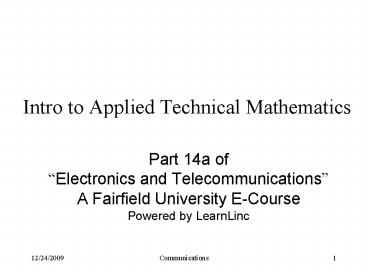Intro to Applied Technical Mathematics PowerPoint PPT Presentation
1 / 14
Title: Intro to Applied Technical Mathematics
1
Intro to Applied Technical Mathematics
- Part 14a ofElectronics and TelecommunicationsA
Fairfield University E-CoursePowered by
LearnLinc
2
Section 14 Schedule
3
Section 14 Applied Technical Mathematics
- Math review
- Binary numbers (Hex and Octal)
- Powers of ten
- Working with equations
- DC AC Motors and Generators
- Simple relationships and vocabulary
- Levers and Gears
- Relating linear force and motion to rotational
torque and motion - FMA vs TJ?
- Torque, RPM and Horsepower
- Simple relationships and vocabulary
4
Solving Equations
- Test tube example (pp. 123-124)
- How many test tubes can be filled to 0.6
milliliters (ml) from a container which contains
60 ml.
5
Algebraic Order
- In mixed operations follow the algebraic order
- Multiply/divide
- Add/subtract
- Alternately, use parenthesis to make things clear
6
Number Systems
- Decimal Numbers (we have 10 fingers)
- 2705 2103 7102 0101 5100
- Zero is a place holder (an Arab invention)
- Replaced Roman Numerals (MCMXVIII1943)
- Binary Numbers
- Based on powers of 2 (the base or radix)
- 1010 123 022 121 020 10 decimal
- k bits can count up to 2k 1 (2k values
including zero) - 8-bits ? 256 values, 16-bits ? 65536 values (64k
binary) - 10-bits ? 1024 values (1k binary)
- 20-bits ? 1,048,576 values (1 meg binary)
- Well suited for our 2-valued digital logic
(computers)
7
Adding Binary Numbers
- Lets do an example17 00010001 (eight
bits)11 0000101128 00011100 (watch out
for carries) 16 8 4 - Another example17 00010001-5 11111011
(twos complement again)12 00001100 (the
overflow is ignored) 8 4 - Note that subtraction is done by adding the twos
complement of the subtrahend
8
Octal and Hexadecimal
- Octal 3 bits at a time
- 0 to 7 (eight possible values per digit)
- 374 octal 3647841 192564 252
decimal 011 111 100 binary 025611281641
3211618140201 252 decimal - Hexadecimal 4 bits at a time
- 0 to 9, A to F (16 possible values per digit)
- 0FC Hex 02561516121 24012 (0000 1111
1100 binary) 252 decimal
9
Powers of 10, Scientific Notation
- 1.5372103 1537.2
- Multiplying by 1000
- Move the decimal point 3 spaces to the right
- 672.57 10-3 0.67257
- Dividing by 1000
- Move the decimal point 3 spaces to the left
10
Equations
- Term1 Term2
- Add (or subtract) the same number to both sides
- Multiply (or divide) both sides by the same
number(except zero) - Square (or take the square root of) both sides
- Use the same function on both side (sine, arccos,
log ) - 3y 6x 3 and x 2first divide both sides
by 3 y 2x 1now substitute for x y
22 1 5 (you could have done this in the
other order)
11
Again
- 3y 6x 3 and x 2first substitute for x
3y 62 3 or 3y 15 now divide both
sides by 3 y 5 (the same answer)
12
Two Equations and Two Unknowns
- It turns out that you can add equations2x 3y
7, 3x - 2y 4multiply the first equation by 2
and the second by 34x 6y 149x - 6y 12
now add13x 26 or x 2now substitute this
value back into the first equation22 3y 74
3y 73y 7 - 4 3 or y 1Well do more
examples later in this section
13
FOILing
- Multiplying two expressions(ab)(cd) ac
bc ad bdFOIL First, Inner, Outer, Last - (x5)(2x2) 2x210x2x10 2x212x10
- This is a second-order polynomial in powers of x
- It is non-linear (linear only has x1 and constant
terms) - Second order polynomials are called quadradic
- (x5) and (2x2) are its factors
- Some people get good at factoring
polynomials(also called unFOILing)
14
Section 14 Schedule

